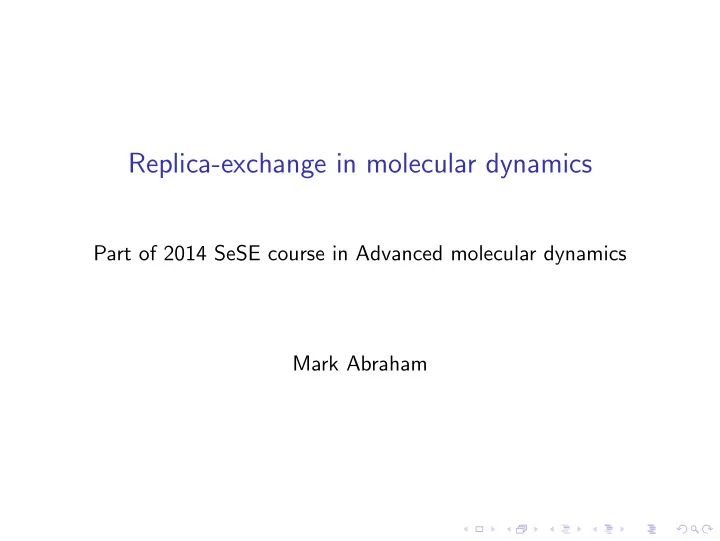

Replica-exchange in molecular dynamics Part of 2014 SeSE course in Advanced molecular dynamics Mark Abraham
Frustration in MD
Frustration in MD ◮ different motions have different time scales ◮ bond vibration, angle-vibration, side-chain rotation, diffusion, secondary structure (de)formation, macromolecular events, . . . ◮ need a short enough time step ◮ a model that doesn’t get enough fine detail right will struggle with higher-level things, too
Barriers in MD F x
Frustration in MD ◮ barriers more than a few kT exist, and are hard to cross ◮ need extremely large amount of brute-force sampling to get over them ◮ makes solving problems like protein folding exceedingly expensive
Ways to grapple with the problem ◮ give up on fine detail, and use a coarse-graining approach ◮ accelerate the sampling (work smarter!) ◮ throw more hardware at it (e.g. Folding@Home) ◮ write faster software (hard, very hard)
Accelerating the sampling ◮ if the problem is that kT is too small.. 1. increase T 2. sample widely 3. . . . 4. profit! ◮ unless the landscape changes. . .
Accelerating the sampling - heating it up F x
Simulated tempering ◮ use Monte Carlo approach to permit system to move in control parameter space ◮ typical control parameter is temperature (but not essential) ◮ typically sample the system only when at temperature of interest ◮ correct if the (Metropolis) exchange criterion is constructed correctly ◮ how? For a state s P (( β, s ) → ( β ′ , s )) = min(1 , w ( β ′ , s ) w ( β, s ) ) 1 where β = kT and w ( β, s ) = exp [ − β U + g ( β )]
Simulated tempering (2) ◮ correct if the exchange criterion is constructed correctly ◮ the optimal g ( β ) is the free energy. . . ◮ so you’re good if you already know the relative likelihood of each conformation at each temperature ◮ works great if you already know the answer to a harder problem than the original ◮ (but you can use an iterative scheme to converge on the answer)
Parallel tempering (a.k.a replica exchange) ◮ side-steps the prior-knowledge problem by running an independent copy of the simulation at each control parameter ◮ (note, throwing more hardware at the problem!) ◮ now the exchange is between copies at different control parameters, each of which is known to be sampled from a correct ensemble already ◮ this eliminates g ( β ) from the generalized exchange criterion. . .
Parallel tempering - the exchange criterion P (( β, s ) ↔ ( β ′ , s ′ )) = min(1 , w ( β, s ′ ) w ( β ′ , s ) w ( β, s ) w ( β ′ , s ′ ) ) which for Boltzmann weights reduces to = min(1 , exp[( β ′ − β )( U ′ − U )])
Parallel tempering - understanding the exchanges
Parallel tempering - is this real? ◮ recall that P ( β s ) ∝ exp[ − β U ( x )] ◮ any scheme that satisfies detailed balance forms a Markov chain whose stationary distribution is the target (generalized) ensemble ◮ so we require only that P (( β, s )) P (( β, s ) → ( β ′ , s )) = P (( β ′ , s ′ )) P (( β ′ , s ′ ) → ( β, s ′ )) ◮ . . . which is exactly what the exchange criterion is constructed to do
Parallel tempering - is this real? (2) ◮ high temperature replicas hopefully can cross barriers ◮ if the conformations they sample are representative of lower-temperature behaviour, then they will be able to exchange down ◮ if not, they won’t
Ensembles used ◮ natural to use the NVT ensemble with an increasing range of T and constant V ◮ there’s a hidden catch - must rescale the velocities to suit the new ensemble in order to construct the above exchange criterion ◮ probably this should use a velocity-Verlet integrator ( x and v at same time) ◮ in principle, can use other ensembles like NPT
Ensembles used (2) ◮ NVT at constant volume must increase P with T ◮ that seems unphysical ◮ worse, the force fields are parameterized for a fixed temperature ◮ but the method doesn’t require that the ensembles correspond to physical ones ◮ merely need overlap of energy distribution ◮ how much overlap determines the probability of accepting an exchange
Problems with replica exchange ◮ molecular simulations typically need lots of water ◮ thus lots of degrees of freedom ◮ energy of the system grows linearly with system size √ ◮ width of energy distributions grow as size ◮ need either more replicas or accept lower overlap
Unphysics is liberating ◮ if there’s no need to be physical, then may as well be explicit about it ◮ large number of schemes proposed ◮ example: resolution exchange ◮ run replicas at different scales of coarse graining ◮ at exchange attempts, not only rescale velocities, but reconstruct the coordinates at the higher/lower grain level
Hamiltonian replica exchange ◮ replicas can be run varying some other control parameter ◮ e.g. gradually turn on some biasing potential ◮ can construct higher-dimensional control-parameter schemes also ◮ in a free-energy calculation, exchange between both alchemical transformation parameter λ and temperature
Replica exchange with solute tempering ◮ selectively “heat” only a small region of the system ◮ modify the parameters to scale the energy, rather than heating ◮ remember P ( β s ) ∝ exp[ − β U ( x )] ◮ advantage that the energy distribution of only part of the system increases over control parameter space ◮ needs many fewer replicas for a given control parameter space ◮ implemented in GROMACS with PLUMED plugin
Questions?
Recommend
More recommend